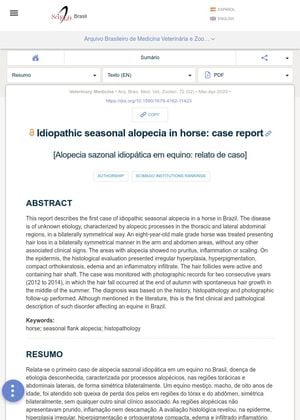Idiopathic Seasonal Alopecia in Horse: Case Report
April 2020
in “
Arquivo Brasileiro De Medicina Veterinaria E Zootecnia
”

TLDR A horse in Brazil had seasonal hair loss possibly linked to light exposure and melatonin levels.
In 2020, a case of idiopathic seasonal alopecia was reported in an eight-year-old male horse in Brazil, the first of its kind in the country. The horse experienced symmetric hair loss in the arm and abdomen areas without any other clinical signs. Histological evaluation showed irregular hyperplasia, hyperpigmentation, compact orthokeratosis, edema, and an inflammatory infiltrate, but active hair follicles with hair shafts. The horse was monitored from 2012 to 2014, with hair loss at the end of autumn and spontaneous hair growth in the middle of the summer. The study suggested a possible link between the condition and photoperiodism, as well as the concentration of circulating melatonin. However, melatonin administration in dogs with the same condition did not yield consistent results. The document concluded that idiopathic seasonal alopecia should be considered in the differential diagnosis of non-pruriginous symmetric alopecia cases in horses.





